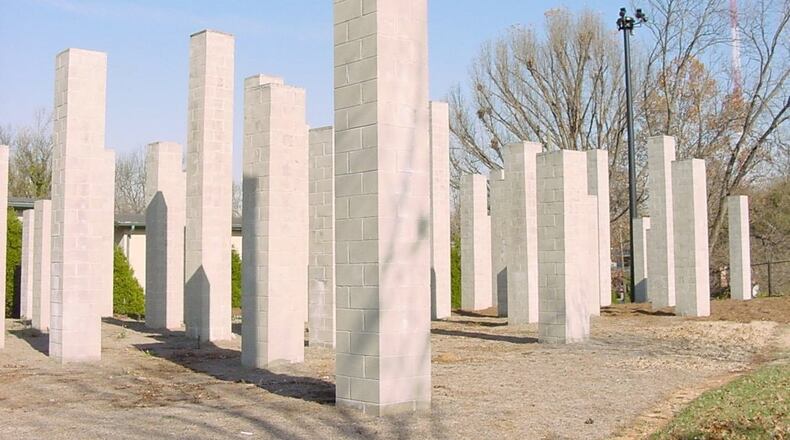Public art is arguably the most democratic art form. It’s available to everyone and costs nothing to admire. The best public art becomes as much a part of a city’s identity as its architecture, its parks and the people who lend a place its character.
Atlanta, like many cities, has public art of several varieties. There is the City of Atlanta and Fulton County public artwork paid for through a law earmarking 1 percent of capital expenditures to public art projects. And then there is the indie art of the city, done by groups like the nonprofit Living Walls devoted to bringing notable mural art to Atlanta and by Loss Prevention, which also serves up compelling public artworks that connect with a long, vital tradition of political murals and street art.
The beauty of public art in our present age of quarantine is that you can see a lot of it without even leaving your car. Many pieces are visible from major thoroughfares. Depending on your routes for essential travel, some of them may be viewed during the state’s latest shelter-in-place order.
For even more inspiration, consult the City of Atlanta Public Art Tour app for a survey of artworks you can find throughout the city.
These four pieces distill Atlanta to its essence as the cradle of the civil rights movement, as a city filled with talented street artists and as a home to countless reminders to look for inspiration everywhere.
‘54 Columns’
You wouldn’t guess from its subtle placement in the landscape that “54 Columns” was steeped in controversy. Created by renowned New York minimalist Sol LeWitt, this arrangement of 54 concrete masonry pillars of varying heights that was donated to Atlanta by longtime art supporters, the Charles Taylor family, was installed in 1999. Successive paroxysms of outrage followed.
At various points in its history, critics have aired their grievances by painting one of the concrete staffs bright pink — “commentary” that was eventually removed. Neighbors unhappy with the sculpture in 2003 planted dogwoods between the pillars to “beautify” the area. Those trees were also removed, relocated to the perimeter of the sculpture. For these reasons, the artwork exemplifies the age-old question “is it art?” As if in response, Art in America named “54 Columns” among the top public art projects of the year in 2000.
Even today, “54 Columns,” called “Atlanta’s Stonehenge” by the Roadside America website, elicits confusion. The piece has often been decried as looking like an abandoned construction site, which you could just as easily say about Atlanta as a whole, with its skyline dominated by cranes as far as the eye can see and the myriad skeletal forms of buildings in progress.
Although visible from the street, fans of the artwork recommend “54 Columns” be experienced by walking around it and through it to fully appreciate LeWitt’s evocation of a city skyline in the work.
Intersection of Highland Avenue NE and Glen Iris Drive NE, Old Fourth Ward
‘Hero’
The towering, seven story-tall mural in Atlanta’s Sweet Auburn district is an homage to Georgia’s fifth district congressman, John Lewis, an Alabama sharecropper’s son and a pillar of the civil rights movement who has come to embody American values of endurance, justice and fairness against all odds.
The mural was created over the course of eight days by Sean Schwab, an Atlanta-based artist with the Loss Prevention arts collective. At the time of the mural’s dedication, Lewis wrote on his official website, “It means a great deal to me that the mural was depicted in the same community where Martin Luther King Jr. was born and nurtured. It is an inspiration to me, and I hope it will inspire others.”
The mural is painted in the stenciled vernacular of street art and Russian Constructivism reminiscent of street artist Shepard Fairey, who created the iconic 2008 Barack Obama “Hope” poster.
As in that Obama campaign portrait, Lewis’ gaze extends beyond the building where the mural resides, into the heavens and eternity, a suitable summation of the Congressman’s perpetual optimism and quest for positive change. The asterisk with the word “Hero” is a nice, subversive touch, a casual aside to announce what Atlantans already know — that Lewis is a hero, an icon.
Although you will miss the Lewis quote — an excerpt from his powerful 1963 March on Washington speech — the optimum view of the mural is driving south on the I-75/I-85 Connector because it integrates Lewis into the city’s architecture in such a significant way, making him part of the spiritual and moral firmament of the city.
Corner of Auburn Avenue and Jesse Hill Jr. Drive NE, Sweet Auburn
‘Homage to King’
A public artwork that profits from its placement, “Homage to King” is sited at the crest of a hill at Boulevard and Freedom Parkway, an incredibly well-traveled intersection that can often feel like the gateway to Atlanta. The placement of this steel rendition of Martin Luther King Jr. is fortuitous, offering one of the best views of Atlanta’s skyline, as evidenced by crowds of the newly engaged, tourists and “Walking Dead” fans who gather for selfies at the Jackson Street Bridge nearby. The sculpture allows King dominion over this prime, picture-postcard real estate.
The Cultural Legacy Initiative commissioned “Homage to King” to bring important public works to Atlanta — in this case by way of Barcelona (the site of the 1992 Olympics) and artist Xavier Medina-Campeny — in a cultural exchange of art in advance of the 1996 Summer Olympics.
The sculpture’s rusted patina speaks to resilience and endurance and the timelessness of King’s message.
Intersection of Boulevard and Freedom Parkway
‘Autoeater’
Castleberry Hill’s Marcia Wood Gallery is responsible for this canny sculptural statement about Atlanta’s driving culture. Created by the Munich and New York-based artist collaborators Venske & Spänle, “Autoeater” depicts a hunk of marble with the wrinkled folds of a sock swallowing an automobile — specifically, a Fiat Panda. The piece is, of course, infinitely relatable to Atlantans who have a love-hate relationship to their cars.
Venske & Spänle were selected by members of the Midtown Alliance’s public art committee to create the 16-ton sculpture that manages to look both ethereal and epic in the duo’s characteristic transformation of the ubiquitous material of high-end kitchens — Italian Carrara marble — into sensuous, organic form.
Julia Venske and Gregor Spänle have described artistic influences as varied as the Smurfs and Minimalism.
The piece also has a suggestive sexual connotation, as if the car — symbol of capitalist might upended to reveal its rarely seen undercarriage — is being enveloped in an enormous prophylactic. Ancient, timeless marble, the material of countless, indelible Greek and Roman sculptures and temples, devours an icon of modernity, the car, suggesting a triumph of the eternal over the transient.
The property where “Autoeater” is sited is leased to the Midtown Alliance for $1 per year by Dewberry Capital Corporation. “Autoeater” is slated for removal this summer, although Brian Carr with the Midtown Alliance notes that the fallout from COVID-19 disruptions could make that timeline subject to change.
Intersection of 10th and Peachtree streets
About the Author
Keep Reading
The Latest
Featured





